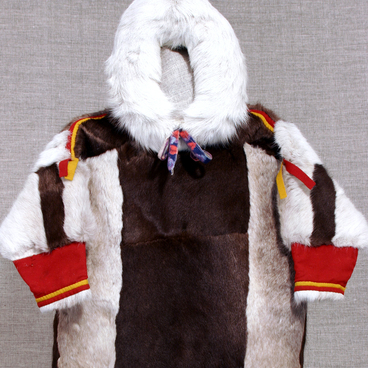In the recent past, shamanism was the most popular religious practice among the Forest Nenets. Usually the most gifted people became shamans, the Nenets believed them to have been spirits chosen. It was only men, because ceremonies demanded physical strength. The Nenets addressed to a shaman almost on every important occasion like illness, hunting or missing reindeers. Shamans performed a special set of ritual actions called ‘kamlAnie’.
According to the Nenets beliefs, kamlAnie was a way shamans interacted with spirits. They used different items of plant or animal origin for their ceremonies. Among them were pieces of skin from the front paw of an otter, a fluffy predator inhabiting northern rivers and lakes. As a beaver or a sable, an otter is a sacred animal for the Forest Nenets. Although it doesn’t mean one cannot hunt it — in winter, the Nenets always used to do so. Otter fur was used for making hats, bones and skin odds were carefully collected. By burning pieces of skin and paws on a special tray, the Nenets shamans conducted ceremonies of cleansing and censing a chum.
Today this practice is almost forgotten and there’s almost no such outstanding ethnos representatives as shamans left. Some of their duties are carried out by elder women in families. The most extensive damage to the Nenets traditional beliefs was caused by the Soviet anti-religious campaign of the 30s of the 20th century. Repressions against shamans almost abolished traditional ideology, destroyed a wholesome system of the Nenets’ religious, moral and ethical principles. They are still afraid to openly display their religious beliefs.
One can find a shaman’s ritual belongings in ethnographical expositions in museums nowadays. An otter paw from Gubkinsky Museum of the Development of the North collection supplements the theme of shamanism in the exposition.
According to the Nenets beliefs, kamlAnie was a way shamans interacted with spirits. They used different items of plant or animal origin for their ceremonies. Among them were pieces of skin from the front paw of an otter, a fluffy predator inhabiting northern rivers and lakes. As a beaver or a sable, an otter is a sacred animal for the Forest Nenets. Although it doesn’t mean one cannot hunt it — in winter, the Nenets always used to do so. Otter fur was used for making hats, bones and skin odds were carefully collected. By burning pieces of skin and paws on a special tray, the Nenets shamans conducted ceremonies of cleansing and censing a chum.
Today this practice is almost forgotten and there’s almost no such outstanding ethnos representatives as shamans left. Some of their duties are carried out by elder women in families. The most extensive damage to the Nenets traditional beliefs was caused by the Soviet anti-religious campaign of the 30s of the 20th century. Repressions against shamans almost abolished traditional ideology, destroyed a wholesome system of the Nenets’ religious, moral and ethical principles. They are still afraid to openly display their religious beliefs.
One can find a shaman’s ritual belongings in ethnographical expositions in museums nowadays. An otter paw from Gubkinsky Museum of the Development of the North collection supplements the theme of shamanism in the exposition.



